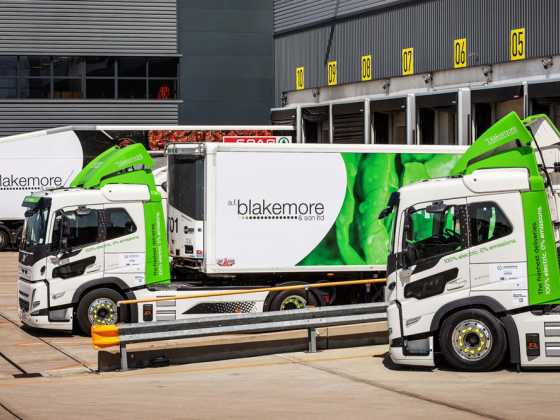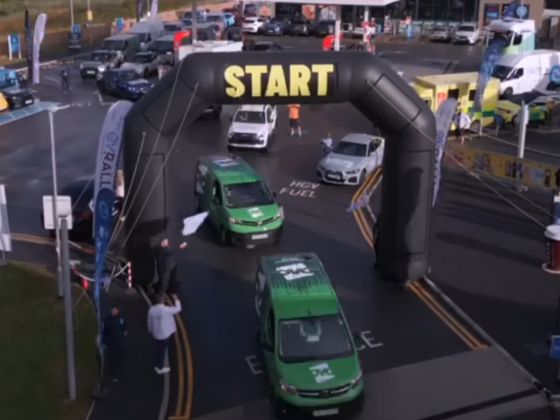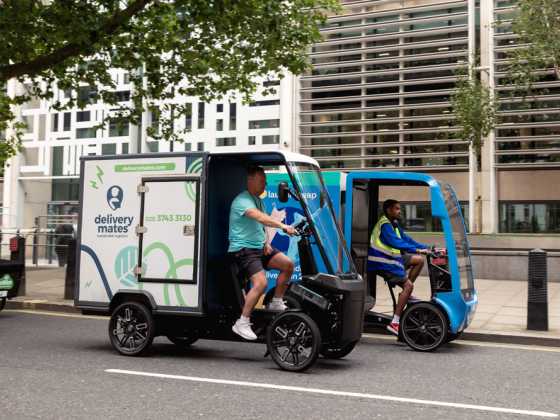Safety, the environment and HGVs: conflicting agendas?
Safety issues regarding HGVs is a topic that continues to rise in profile. Freight Transport Association’s Christopher Snelling discusses solutions that could improve road safety and possibly benefit the environment as well.
 Over the last few years the issue of the safety of other road users around Heavy Goods Vehicles (HGVs) has risen in profile. In fact, the reality is that in the past 10 years alone we have halved the number of HGVs involved in fatal incidents – and that is on the back of already impressive reductions up to then. This progress is still continuing. In the most recent set of figures (for 2014) we saw a year-on-year drop in HGV fatality rate of 3.5 per cent. Across the board, HGVs are involved in only three per cent of accidents – lower than the share of road traffic they make up.
Over the last few years the issue of the safety of other road users around Heavy Goods Vehicles (HGVs) has risen in profile. In fact, the reality is that in the past 10 years alone we have halved the number of HGVs involved in fatal incidents – and that is on the back of already impressive reductions up to then. This progress is still continuing. In the most recent set of figures (for 2014) we saw a year-on-year drop in HGV fatality rate of 3.5 per cent. Across the board, HGVs are involved in only three per cent of accidents – lower than the share of road traffic they make up.
The HGV safety landscape
Why then is lorry safety now seen as such an urgent issue? The answer, partly, is that however much things improve, one death or serious injury is one too many. As we make progress, expectations also rise, and until our roads are completely safe this issue will not go away.
However, the more urgent issue that has driven safety up the political agenda is cycling. Whilst there are still broadly positive trends for all other road users groups, for cyclists the number of fatalities and serious injuries is not improving. This is, to a certain extent, due to the increased amount of cycling that is being done in the UK, but that does not completely explain the rise.
But why focus on HGVs? While the Killed or Seriously Injured (KSI) figures are lower or proportionate to our levels of traffic, it is when you separate out just fatalities amongst cyclists that the picture changes. Across Britain, HGVs are consistently involved in around 20 per cent of cyclist deaths. A further element is London. In London HGVs are consistently involved in the majority of cyclist deaths (on average 55 per cent), and so far in 2015 the proportion is even higher with lorries involved in seven out of nine cycling fatalities. As so often in the UK, the London perspective – for good or ill – dominates the national agenda.
Actions underway
So given this agenda, what is being done? One form of action, of which the Freight Transport Association (FTA) is very supportive, is increased targeted enforcement of HGV vehicle and driver regulations. Feedback from Transport for London (TfL) tells us that rogue operators who do not make sufficient attempts to follow core safety requirements (or even deliberately work outside them, for example, fake HGV licences) are over‑represented in the fatalities. London’s Freight Enforcement Partnership draws from the skills and competencies of many agencies and focuses extra efforts on high risk operators. Its targeted nature means that it has a high success rate in stopping those operators with problems.
Also on the agenda is continued improvements to general vehicle features – incremental improvements to things such as mirrors and sideguards by the EU and Department for Transport that will continue to deliver progress on the roads.
A more aggressive regulatory approach has been pursued in London: the Safer Lorry Scheme (SLS) came into existence in September this year. It requires all HGVs to have sideguards and class V and VI mirrors fitted. In January TfL will consult on the future direction of the SLS – with requirements for physically reducing the size of vehicles’ blind spots on the cards (for example through requiring the fitting of a transparent passenger door lower panel).
An area of specific focus is construction logistics – essentially the tipper vehicle. As a sector these operations are over represented in the fatalities. Of those seven HGV-related cyclist fatalities in London this year, five have involved tippers, despite them making up only around ten per cent of HGVs. This is typical of the picture over a number of years. Therefore, another project the FTA supports is the Construction Logistics and Cycling Safety programme (CLOCS). Part of this work sets out an enhanced safety standards designed for tippers (which have larger blind spots than typical HGVs of that size) for use by the procurers of construction logistics services in their contacts.
For the longer term there are efforts to redesign HGV cabs so that more direct vision is possible and blind spots are reduced at source. Technological solutions will also come into play. As of now, new HGVs have to have a first generation of autonomous emergency braking fitted. Whilst this first iteration won’t prevent interaction with cyclists, future upgrades should provide the best technological fix we can get.
Aside from all this, the logistics industry is improving driver training and the focus on vulnerable road user issues is growing. Operators in all logistics sectors are increasingly fitting cameras and sensors to vehicles to minimise the chance of a collision.
But despite all this, a clamour for a simple, easy‑to‑understand, satisfying, radical action remains – lorry bans.
Rush hour HGV bans
This concept has been floated in London by MPs, local councils and campaigners. The latest proposal is from the London Cycling Campaign (LCC), which is calling for ‘a HGV ban’ on London’s roads from 8.00 to 9.30 five days a week. They argue that this would avoid 40 per cent of HGV-related cyclist fatalities. In November the London Assembly unanimously called on the current Mayor to implement such a policy subject to an impact assessment. The Mayor has previously considered the policy – when even his own Cycling Commissioner found it lacking. The fact that the detail does not make as much sense as its advocates would hope does not stop it coming forward.
So, why does the FTA believe rush hours bans are not the way? On safety grounds alone the idea does not stack up. Firstly, they are not a magic bullet – the LCC’s own figures show that they would effect on average three of 14 cycling fatalities each year in London. Secondly, such a narrow focus on cyclists forgets the needs of other vulnerable road users. It is an unfortunate fact that twice as many pedestrians are killed in incidents with HGVs than cyclists. TfL tells us that the majority of pedestrians are killed at night (between 7pm and 7am). Equally, the 9.30 end of the proposed ban would coincide with the time the most vulnerable pedestrians such as pensioners are taking to the streets. Thirdly, such a plan neglects to consider how operators would have to react to cope with a ban. Many would down-size their vehicles to avoid the restriction. The reality is that vans have twice the fatality rate with cyclists per tonne carried compared to HGVs, not to mention their interaction with other road users such as motorcyclists and pedestrians, meaning the bunching of HGVs before and after the restriction could potentially create new safety issues on the road.
All this is to leave aside the massive impact such a ban would have on all business in London. Bakers, cafes, retailers, workshops, offices and construction sites depend on having goods supplied by the start of the work day. While some deliveries could be done in the night, many – especially small businesses – cannot.
One of the main potential downsides of the concept of a lorry ban is the impact on the environment – both in terms of local air quality and greenhouse gases.
As noted above, one of the main ways to continue working would be to down-size vehicles. The consequences of any general reduction in the size of vehicles typically used would be highly negative. What matters is not emissions per vehicle but emissions per payload or delivery. Given the environmental economies of scale that larger vehicles bring, replacing larger HGVs with smaller ones, or worse with vans, would multiply the emissions of local air pollutants and greenhouse gases.
There is also the consequence of increased movements or idling, as banned HGVs have to patrol the perimeter or just wait as the end of the restriction comes into sight.
Above all there would be a negative impact though increased congestion as multiple smaller vehicles replace HGVs at rush hour. As stop-start traffic increases, the emissions from all vehicles types increases.
The hopeful picture: possible synergies
However, the picture is not all bad. While some ideas like rush hour bans could create significant emissions problems, others could result in complementary environmental benefits. Reform of vehicle design regulations in the EU has focused on both safety and the environment – with additional features that could reduce blind spots but also improve aerodynamics. This approach is a highly beneficial way forward as it works with the market by enabling operators to make financial gains to offset the costs involved.
There is also the possibility of out-of-hours deliveries. Not all deliveries can be moved out of the peak, but some can. If we can reform the regulations that prevent night-time deliveries in London, and integrate them into the operating practices of suitable operators and customers, it could move notable volumes out of the time of maximum clash with cyclists – and also into a time when the roads are more free-flowing, thus reducing emissions.
Above all, the technological approach can offer synergies. Technology which can monitor driver performance can spot high-risk driving just as much as high fuel use. Longer term, driver aides can both smooth vehicle use further and prevent many collisions with other roads users – not just cyclists but pedestrians, motorcyclists and car users as well.
It is these more intelligent approaches that FTA is pursuing with its members and is advocating to government in all its forms. We remain hopeful that when the shouting is over, calm consideration of the best approaches for safety and emissions will win out.
Further Information
www.fta.co.uk






